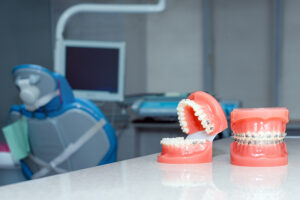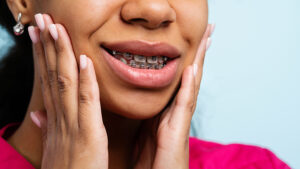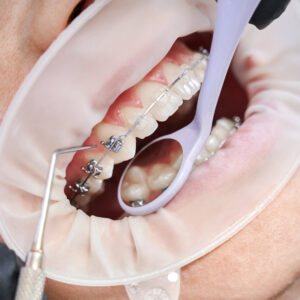Many of us are familiar with the sight of braces, those intricate devices that seem to magically straighten teeth over time. However, few understand exactly how they accomplish this feat. How do braces work in aligning crooked teeth and correcting bite issues? Discover the mechanisms behind braces, exploring their design, function, and the benefits they offer beyond just a straighter smile.
What Are Braces?
Orthodontic braces are tools designed for correcting issues with teeth alignment and bite problems. They apply continuous pressure over a period, slowly moving teeth into the desired position. But braces aren’t a one-size-fits-all solution; they come in various types to suit different needs and preferences.
Types of Braces
- Traditional Metal Braces: The most common type, made of high-grade stainless steel, attached to each tooth and connected by a thin archwire. These braces are visible but highly effective.
- Ceramic Braces: Similar to metal braces in function but made of transparent ceramic material, making them less noticeable.
- Lingual Braces: Attached to the back of the teeth, lingual braces are invisible from the front but can be more uncomfortable and harder to clean.
- Clear Aligners: A series of custom-made, clear plastic aligners, virtually invisible, and removable for eating and cleaning. They are a popular choice for adults.
A Brief History of Orthodontic Braces
The journey of braces from their inception to the modern-day is a testament to the advancements in dental technology. The concept of straightening teeth has been around since ancient times, with evidence of rudimentary braces found in mummified remains. However, it wasn’t until the 18th century that experts made significant progress, culminating in today’s sophisticated systems that offer both efficiency and aesthetics.
Braces have evolved from simple bands wrapped around teeth to the highly effective appliances we see today. This evolution reflects ongoing research and technological advancements aiming to improve comfort, reduce treatment time, and enhance outcomes for patients of all ages.
How Do Braces Work?
How do braces work, you ask? The core principle behind braces lies in the application of pressure. This continuous force, over time, encourages teeth to move into a more aligned position. Understanding this process requires a closer look at tooth anatomy and the role of various braces components.
Tooth Anatomy and Movement
Each tooth is anchored into the jawbone by a root, surrounded by a periodontal ligament. This ligament contains fibers that connect the tooth to the bone, acting as a shock absorber for the forces the tooth experiences. When braces apply pressure to a tooth, it creates a force that is transmitted through the crown of the tooth to the root and the surrounding bone. This pressure causes a remodeling of the bone and ligament, allowing the tooth to move. On the side of the pressure, the bone is resorbed, and on the opposite side, new bone is formed.
Components of Braces and Their Functions
- Brackets: These are the small squares that orthodontists attach to the front of each tooth. Brackets act as handles, holding the archwire that moves the teeth. Modern brackets are made from metal, ceramic, or plastic.
- Archwire: The archwire is a thin metal wire that runs through each bracket and applies pressure to the teeth. As the wire tries to return to its original shape, it pulls or pushes the teeth to their new positions.
- Ligature Bands or Ties: These are small rubber bands or fine wires that fasten the archwire to the brackets. They can be clear, metal, or colored, depending on the patient’s preference.
- Other Components: Depending on the patient’s needs, additional parts like spacers, bands, or springs may be used to apply more force in a specific direction or to spaces where teeth need to move.
How do braces work? Through the coordinated effort of these components, braces exert sustained pressure on teeth. This controlled force is what makes it possible to move teeth into better positions over time, leading to improved alignment and bite. The process is gradual, with adjustments made periodically by an orthodontist to ensure progress is on track toward achieving the desired outcome.
Life With Braces
Adjusting to life with braces involves understanding how to care for them and managing the changes they bring to daily routines. Here’s what to expect and how to make the experience as smooth as possible.
Daily Care and Maintenance
Good oral hygiene is crucial for preventing issues such as cavities and gum disease, especially when wearing braces. Here are some tips to keep your braces and teeth clean:
- Brushing: Use a soft-bristled toothbrush and fluoride toothpaste to brush around each bracket and wire. It’s advisable to brush after every meal to remove food particles and plaque.
- Flossing: Special orthodontic floss or floss threaders can help navigate around wires and brackets to remove debris between teeth.
- Rinsing: An antiseptic dental rinse may be recommended by your orthodontist to help reduce inflammation and irritation caused by braces.
Foods to Avoid
Certain foods can damage braces or get stuck in them, leading to potential oral health issues. It’s best to avoid:
- Hard foods: Such as nuts, ice, and hard candies that can break brackets or wires.
- Sticky foods: Like caramel, gum, and certain candies
- Highly pigmented foods and drinks: Such as coffee, red wine, and some fruits can stain teeth and braces.
Managing Discomfort and Common Issues
It’s normal to experience some discomfort after getting braces or following adjustments. Here are ways to manage it:
- Pain relief: Over-the-counter pain relievers can alleviate discomfort. Always follow the recommended dosage.
- Oral care products: Brace wearers can apply wax to brackets that irritate the inner cheeks or lips, and a saltwater rinse can soothe sore gums.
Duration of Treatment
The length of time needed to wear braces varies depending on the individual’s dental alignment issues and how well they adhere to their orthodontist’s advice. Generally, treatment can last anywhere from 18 months to 3 years. Consistent follow-ups and proper care can help ensure the treatment stays on schedule.
Beyond Straight Teeth: Additional Benefits of Braces
How do braces work in improving your oral health? While the primary goal of orthodontic braces is to align teeth and correct bite issues, the benefits extend far beyond aesthetics. Braces can significantly improve oral health and functionality, leading to a better quality of life. Here’s a closer look at some of these additional benefits.
Improved Oral Health
Straight teeth are easier to clean than crooked or crowded ones. By aligning the teeth, braces help reduce the risk of cavities and gum disease. Properly aligned teeth allow for more effective brushing and flossing, reducing plaque buildup and the risk of periodontal disease.
Enhanced Bite and Jaw Alignment
A misaligned bite can cause numerous problems, from difficulty chewing food to excessive wear on certain teeth. It can also lead to jaw pain and TMJ (temporomandibular joint) disorders. Braces work to align the bite, ensuring that the upper and lower teeth fit together properly. This correction can alleviate or prevent pain and functional problems, improving overall jaw health.
Boost in Self-Confidence and Aesthetic Improvements
One should not underestimate the psychological impact of an improved smile. Many people with misaligned teeth feel self-conscious about their appearance. Correcting dental issues with braces can lead to a significant boost in self-esteem, encouraging a more positive self-image. The aesthetic improvements can enhance social and professional interactions, contributing to a better overall quality of life.
Prevention of Dental Injuries
Protruding upper teeth are more likely to be damaged in accidents. By repositioning these teeth, braces reduce the risk of fracturing or chipping in the event of a fall or impact. This protective effect is especially beneficial for individuals who play sports or engage in physical activities.
Improved Speech
Teeth play a crucial role in speech. Misalignments can lead to speech difficulties, including lisps and other articulation problems. By correcting the alignment of teeth and bite, braces can help improve speech clarity and fluency.
Long-Term Savings
Investing in braces can lead to long-term savings in dental care. Aligned teeth and a corrected bite reduce the risk of future dental problems that could require costly treatments. Preventing issues like cavities, gum disease, and abnormal wear saves money on dental procedures in the long run.
Your Path to a Perfect Smile Starts with Smile Solutions Orthodontics
At Smile Solutions Orthodontics, your journey to a perfect smile is our mission. Led by the experienced Dr. Chung and Dr. Epshteyn, our team is dedicated to providing top-tier orthodontic care in Edison, Millburn, and Union, NJ. We understand that each smile is unique, which is why we offer personalized treatment plans tailored to your individual needs.
Our commitment to excellence is evident in our use of the latest advancements in orthodontic treatment, ensuring you receive the best care possible in a comfortable and welcoming environment. Whether you’re considering traditional braces or the top-rated Invisalign system, our skilled team is here to guide you every step of the way.
Take the First Step Towards a Radiant Smile
Don’t wait any longer to achieve the smile of your dreams. Contact Smile Solutions Orthodontics today to schedule your consultation.




